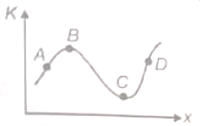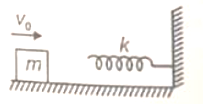For a particle moving under the action of a variable force, kinetic energy-position graph is given, then

1. At A particle is decelerating
2. At B particle is accelerating
3. At C particle has maximum velocity
4. At D particle has maximum acceleration

A particle moves with the velocity under the influence of a constant force, N. The instantaneous power applied is
1. 5 W
2. 10 W
3. 20 W
4. 30 W
A body is projected from ground obliquely. During downward motion, power delivered by gravity to it
1. Increases
2. Decreases
3. Remains constant
4. First decreases and then becomes constant
A body of mass m accelerates uniformly from rest to velocity v1 in time interval T1. The instantaneous power delivered to the body as a function of time t is
1.
2.
3.
4.
The power of a pump, which can pump 500 kg of water to height 100 m in 10 s is
1. 75 kW
2. 25 kW
3. 50 kW
4. 500 kW
Positively charged particles X and Y are initially far away from each other and at rest. X begins to move towards Y with some initial velocity. The total momentum and energy of the system are p and E respectively. Which of the following statement is correct?
1. If Y is fixed, both p and E are conserved.
2. If Y is fixed, E is conserved, but not p.
3. If both are free to move, p is conserved but not E.
4. If both are free, E is conserved, but not p.
A body is falling freely under the action of gravity alone in vacuum. Which of the following quantities remains constant during the fall?
1. Kinetic energy
2. Potential energy
3. Total mechanical energy
4. Total linear momentum
During inelastic collision between two bodies, which of the following quantities always remain conserved?
1. Total kinetic energy
2. Total mechanical energy
3. Total linear momentum
4. Speed of each body
A block of mass m moving with velocity v0 on a smooth horizontal surface hits the spring of constant k as shown. The maximum compression in spring is

1.
2.
3.
4.
A uniform chain of length L and mass M is lying on a smooth table and one third of its length is hanging vertically down over the edge of the table. If g is acceleration due to gravity, the minimum work required to pull the hanging part of the chain on the table is
1. MgL
2.
3.
4.






